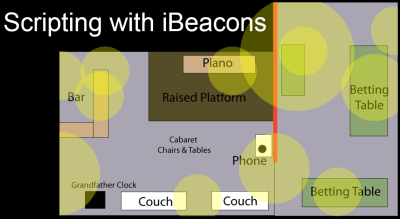Combining backgrounds in math and theater, [Dustin Freeman] works on immersive, interactive theatrical experiences. During the day [Dustin] is a Spatial Interaction Engineer at Occipital, who makes the Structure Sensor. In his spare time [Dustin] works on digital theatre projects that bring the theatre goer far past the traditional row of seats.
The concept of immersive theatre is similar to ‘escape the room’ challenges and choose your own adventure experiences, in that the participants control the outcome of the experience by making decisions from the information supplied to them. [Dustin] explains in his talk that the feeling of trying to beat the clock that exists in escape the room challenges is not helpful in Floodlight’s The Painting. Floodlight is a theatre production company and The Painting is the immersive theatre experience put together by [Joshua Marx], professor of acting at San Jose State and [Dustin Freeman] who presented this 2015 Hackaday SuperConference talk.
The Painting
An immersive, interactive theatre experience requires a physical space for the participants to interact with the environment. To meet this requirement [Dustin] was able to gain access to a bar that is closed during the day. Having periodic access required the immersive theatre setup be done quickly. [Dustin] and [Josh] were able to get this done in under 3o minutes. You can’t do better than to have a real set, and The Speakeasy is a functioning bar ready for character interaction with minimal prep.
The premise of The Painting is that you arrive at The Speakeasy and [Josh] greets you at the door to let you in. As you enter he explains that he is very busy and he needs you to go upstairs and get a painting for him. You are equipped with a smartphone and a set of headphones so that [Josh] can communicate with you.
Technologically Navigated
Props throughout the set include iBeacons. When an iBeacon is detected by the smartphone there are two pieces of information received: the iBeacons ID and the distance from the smartphone to the iBeacon. These parameters require some creative code, not only to move the story along but to decode information received. The data from a sensed iBeacon is a scalar quantity rather than a vector, receiving multiple scalar quantities presents a set of problems that must be carefully solved. As shown in the image below, two iBeacons at the same distance from the smartphone have quantum physical locations. The image above shows how [Dustin] was able to solve the distance problem by varying the active radius of each iBeacon.
To determine how the story might play out [Dustin] used the Wizard of Oz Technique as a way to outline the needed code. By physically playing through the scenarios with [Josh] acting as the Wizard [Dustin] would move a game piece along a printout of The Speakeasy floor plan. This routine was whittled down to 4 variants which the two could turn into scripted navigation based on iBeacon location information.
Real World Issues
When designing the technological side of the production a few hiccups came to light. Most men (at least the two involved in designing The Painting) carry their phone in a front pants pocket. This is not true for everyone, women’s clothing often lack pockets and quite a few people opt for back pocket when holstering their phone given the front/back pocket option. This obviously changes the geometry of sensors to iBeacons which has an effect on when a script event is triggered. In a back pocket or backpack the phone might not get withing the correct range of an item to trigger an event. This problem is not yet solved, but may be fixed with something like a special garment that each participant can wear to normalize the cellphone pocket location.
This is an interesting use of Bluetooth technology and [Dustin] gave an informative talk that included not only what worked but what failed and how/why it failed. In the video and slides [Dustin] asks some good thought-provoking questions that would be a good place to continue this work, if you are interested in using the iBeacon technology in a similar way.
















Beacons are more suited to proximity information rather than position. I’d imagine it’d still be easy to design around events like “they entered the room” and still end up with an impressive show. Either that or sensor fuse with infrared motion sensors in the room to know who/where they are.
See Us Patent 6,738,628,B1 May 18 2004… 11 years ago.. Not really new..Using Bluetooth beacons to track bluetooth devices